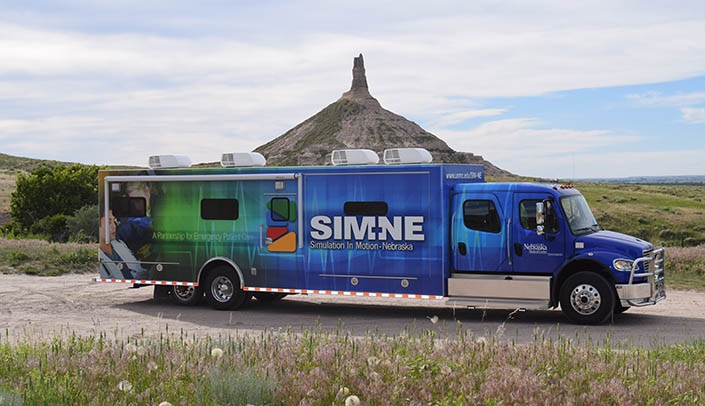UNMC staff have touted the emergency medical services training that has occurred statewide as a result of the Simulation in Motion-Nebraska (SIM-NE) program, and on Jan. 27 urged lawmakers to support a bill that would keep the trucks on Nebraska roads.
“The SIM-NE program can literally impact the health care of every citizen of the state of Nebraska,” said Doug Dekker, simulation program manager for SIM-NE, noting that the program has trained nearly 7,000 individuals, the majority of whom are volunteer emergency medical services (EMS) providers and rural firefighters.
Dekker urged members of the Transportation and Telecommunications Committee to advance LB 761, which would support ongoing operational funding for the SIM-NE program. He was joined by EMS, firefighters and hospital personnel who live and work in communities from Scottsbluff to Valley.
Polly Olson, a national registered emergency medical technician in Chappell, Nebraska, testified in support of LB 761, noting that “training is key to remain competent, and quality education is costly. . . (SIM-NE) has provided classes to our community. . . and ensures that you and those you love and know will be offered the best chance of receiving quality care.”
LB 761, introduced by Sen. Myron Dorn of Adams, Nebraska, supports a 50-cent motor vehicle license fee increase to provide an appropriation from the Nebraska Emergency Medical Systems Operations Cash Fund to UNMC SIM-NE, allowing the program to continue offering high-fidelity simulation training to EMS and critical access hospitals at the current no cost fee structure.
Sen. Dorn, an emergency medical technician for more than 30 years, said SIM-NE provides an invaluable service by bringing critical training to Nebraska’s rural fire departments, rescue squads and rural hospitals. “It means people do not have to leave to receive training in Lincoln or Omaha but the training is right there in their home town for a few hours,” he said.
Stationed in Scottsbluff, Norfolk, Kearney and Lincoln, each mobile unit is equipped to recreate a realistic environment for learners including monitors that display vital signs of patient simulators, heart monitors/defibrillators, audio and video recording/playback capabilities and mock drugs.
Through the SIM-NE training, “we are bringing $1 million worth of truck, equipment and supplies right to the volunteers or critical access hospital staff,” Dekker said.
Since its launch in January 2017, the four SIM-NE trucks collectively have:
- Traveled over 62,000 miles across the state or more than 2 1/2 times around the Earth;
- Provided more than 20,000 free continuing education training hours to volunteer EMS providers, firefighters and critical access hospital staff of Nebraska;
- Trained 6,953 individuals; and
- Trained at least one agency in 87 of Nebraska’s 93 counties.
SIM-NE initially was launched with a $5.5 million start-up grant from The Leona M. and Harry B. Helmsley Charitable Trust. Since that grant expired, UNMC has raised approximately $865,000 through private philanthropy to bridge the SIM-NE operational needs. Unfortunately, the philanthropic dollars only allow the program to continue through May 2020, said UNMC’s Ben Stobbe, assistant vice chancellor of clinical simulation for iEXCEL.
The SIM-NE team has been “good stewards of the funds,” Stobbe said, and noted that the team has refined its budget to keep annual costs under $1 million to cover current program deliverables.
Dekker said SIM-NE’s unique statewide presence allows EMS personnel to train in their local communities, alongside their colleagues. Together, they hone their skills by practicing scenarios they seldom encounter, such as complicated childbirth scenarios, as well as trauma and cardiac cases, which are more routine. “Volunteer providers and critical access hospital staff want to make sure that they are current in best practices,” Dekker said.
Sen. Dorn agreed. “The better trained our rural emergency responders and ER staff is, the better health outcomes of those who have suffered a medical emergency weather on the roads, in their homes, or on the farm.”
